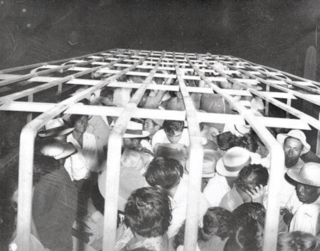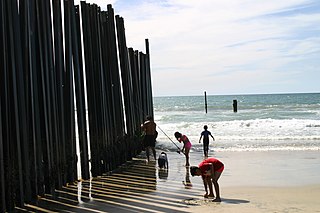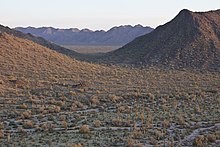
The United States Border Patrol (USBP) is a federal law enforcement agency under the United States Customs and Border Protection (CBP) and is responsible for securing the borders of the United States. According to its web site in 2022, its mission is to "Protect the American people, safeguard our borders, and enhance the nation’s economic prosperity."

The United States border with Mexico is one of the world's "most lethal land borders". Hundreds of migrants die per year as they attempt to cross into the United States from Mexico illegally. The US Border Patrol reported 251 migrant deaths in the fiscal year 2015, which was lower than any year during the period 2000–2014, and reported 247 migrant deaths in fiscal year 2020, lower than any year since 1998. Poverty, gang violence, poor governance, etc. are the main factors as to why migrants cross the US border. US Border Patrol recorded 557 southwest border deaths during fiscal year 2021 and 748 in the first 11 months of fiscal year 2022, the most deaths ever recorded.

Operation Wetback was an immigration law enforcement initiative created by Joseph Swing, the Director of the United States Immigration and Naturalization Service (INS). The program was implemented in June 1954 by U.S. Attorney General Herbert Brownell. The short-lived operation used military-style tactics to remove Mexican immigrants—some of them American citizens—from the United States. Though millions of Mexicans had legally entered the country through joint immigration programs in the first half of the 20th century and some who were naturalized citizens who were once native, Operation Wetback was designed to send them to Mexico.

The Minuteman Civil Defense Corps was a volunteer group at one time headed by Chris Simcox and dedicated to preventing illegal crossings of the United States border with Mexico. Arguing that the government was insufficiently concerned with securing the border, they organized several state chapters, with the intention of providing law enforcement agencies with evidence of immigration law violations. The group was one of several that emerged for the proliferation of civilian border patrol groups at the US-Mexico border. Arguably, the emergence of these groups can be linked to the increasing criminalization and securitization of immigration. Simcox stated that the group merely reported incidents to law enforcement, and did not directly confront immigrants. There was a standard operating procedure (SOP) that was to be followed by Minutemen volunteers, with rules including not speaking to, approaching, gesturing towards or having physical contact in any way with any suspected border crossers. According to Anthony Ramirez of the New York Times, the organization "has been criticized as being a right-wing militia".

The Mexico–United States border is an international border separating Mexico and the United States, extending from the Pacific Ocean in the west to the Gulf of Mexico in the east. The border traverses a variety of terrains, ranging from urban areas to deserts. The Mexico–U.S. border is the most frequently crossed border in the world with approximately 350 million documented crossings annually. It is the tenth-longest border between two countries in the world.

Foreign nationals (aliens) can violate US immigration laws by entering the United States unlawfully or lawfully entering but then remaining after the expiration of their visas, parole, or temporary protected status. Illegal immigration has been a matter of intense debate in the United States since the 1980s.
No More Deaths is an advocacy group based in Tucson and Phoenix, Arizona, United States. The group's stated goal is to end the series of fatalities of undocumented immigrants crossing the desert regions near the United States-Mexico border. Volunteers for the organization provide food, water, and medical aid to people crossing the US-Mexico border through the Arizona desert and offer humanitarian aid to people in Mexico who have been deported from the US.

Illegal entry is the act of foreign nationals arriving in or crossing the borders into a country in violation of its immigration law. Human smuggling is the practice of aiding people in crossing international borders for financial gain, often in large groups. Human smuggling is associated with human trafficking. A human smuggler will facilitate illegal entry into a country for a fee, but on arrival at their destination, the smuggled person is usually free. Trafficking involves physical force, fraud, or deception to obtain and transport people, usually for enslavement or forced prostitution.

Colloquially, a coyote is a person who smuggles immigrants across the Mexico–United States border. The word "coyote" is a loanword from Mexican Spanish that usually refers to a species of North American wild dog (Canis latrans).
The Undocumented is a 90-minute documentary film, released in 2013, directed by Marco Williams, which investigates the causes and effects of migrant deaths along the Arizona-Mexico border.
Illegal immigration in Mexico has occurred at various times throughout history, especially in the 1830s and since the 1970s. Although the number of deportations is declining with 61,034 registered cases in 2011, the Mexican government documented over 200,000 illegal border crossings in 2004 and 2005. The largest source of illegal immigrants in Mexico are the impoverished Central American countries of Guatemala, Haiti, Honduras, and El Salvador and African countries like Democratic Republic of Congo, Cameroon, Guinea, Ghana and Nigeria. The largest single group of immigrants in Mexico is from the United States, at 1.5 million, many of whom overstay their visas. Americans are the largest group of immigrants in Mexico. They number 1.5 million, many of them being without legal status since they overstayed their visas.

The 2014 American immigration crisis was a surge in unaccompanied children and women from the Northern Triangle of Central America (NTCA) seeking entrance to the United States in 2014. According to U.S. law, an unaccompanied alien child refers to a person under 18 years of age, who has no lawful immigration status in the U.S., and who does not have a legal guardian to provide physical custody and care.
Jacumba Valley is a valley in San Diego and Imperial Counties, California. Its head is at 32°37′00″N116°10′07″W Carrizo Creek has its source in Jacumba Valley, 1.2 miles north of the California-Mexico State boundary, at 32°38′09″N116°07′05″W at an elevation of 3,210 feet, on the west side of the divide between Jacumba Valley and the valley of upper Boulder Creek. Carrizo Creek flows west then north northwest through Jacumba Valley to its mouth at the head of Carrizo Gorge. Just south of the Jacumba and In-ko-pah Mountains, the terrain consists of large, flat desert plains and hills of granite boulders. The wider region, including the Jacumba Wilderness, which sits just east of the valley, has been greatly affected by the construction of the US/Mexico border and has become a site of great numbers of migrations along migrant paths.
Border Angels is a San Diego-based 501(c)(3) tax-exempt nonprofit charitable organization that is focused on migrant rights, immigration reform, and the prevention of immigrant deaths along the border. Border Angels, along with its more than 2000 volunteers serves San Diego County's immigrant population through various migrant outreach programs such as day laborer outreach and legal assistance, and provides life-saving assistance for migrants by placing bottled water in remote mountain and desert border regions of the San Diego and Imperial counties, California.
Border enforcement is a type of immigration enforcement whereby a country enforces its immigration laws by trying to prevent people from crossing its border or borders illegally. There are multiple methods a country can use to do this, including patrolling its border and building walls along part or all of it. The term is most commonly used in regards to the efforts by the United States government to prevent people from migrating illegally to the U.S. by crossing the Mexico–United States border. Since 2002, the number of United States Border Patrol agents has more than doubled, to a total of 20,273, and federal spending on the Patrol has increased from $1.4 to $3.8 billion over the same time. In addition to the Patrol, agencies responsible for border enforcement in the U.S. include Immigration and Customs Enforcement.

The Land of Open Graves is a book by anthropologist Jason De León with photographs by Michael Wells. The book examines the human consequences of United States immigration policy. Using research methods from all four subfields of anthropology, De León sheds light on the lives of the thousands of migrants who cross the US border with Mexico daily in the Sonoran Desert of Arizona. The book was published in hardcover and paperback by the University of California Press in 2015 as part of the California Series in Public Anthropology.
The Arizona borderlands are the geographic and cultural region north of the Arizona portion of the US-Mexico border. The area is unique in that it features both an international border and the Tohono O'oham sovereign nation along much of that border. Frequent and persistent topics of interest in the area include the presence of illegal immigration, the confluence of local, state, and national politics surrounding the border, conservation and sustainable living, and the presence of drug traffickers and paramilitary forces in the vicinity.

Hostile Terrain 94 (HT94) is a participatory art project created and organized by the Undocumented Migration Project (UMP). The exhibition is composed of approximately 3,400 handwritten toe tags that represent migrants who have died trying to cross the Sonoran Desert of Arizona between the mid-1990s and 2021. The tags are geolocated on a large wall map of the Arizona/Mexico border, showing the exact locations where human remains were found. This DIY installation is taking place at over 120 institutions––in the U.S. and abroad––with the intention to raise awareness about the humanitarian crisis at America's southern border and to engage with communities around the world in conversations about migration.
Borderland is a limited-run 2014 television documentary series, produced by Australian production company In Films. It was the first original commission for Al Jazeera America's documentary unit, premiering on 13 April 2014. The series followed six Americans as they retraced the fatal journey of three undocumented migrants who died attempting to cross into the United States.
Missing in Brooks County is a 2020 feature-length documentary, directed and filmed by Lisa Molomot and Jeff Bemiss. Its subject is the passage of illegal migrants through Brooks County, Texas, and specifically how thousands die of dehydration and exposure hiking some 35 miles (56 km) across open fields in 100 °F (38 °C) heat, to avoid the Border Patrol internal checkpoint near Falfurrias, Texas. The ground is sandy and taxing to walk in, and lack of landmarks makes it easy for migrants to get lost and go in circles. Brooks County leads the nation in migrant deaths; most bodies are never found, and most of those found are never identified. The county sheriff calls the county "the biggest cemetery in the United States". News stories have called it "migrants' Death Valley."











